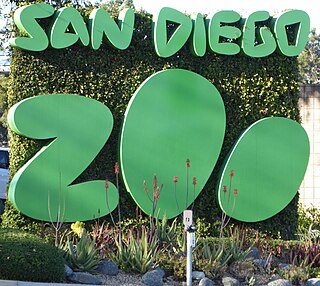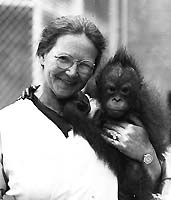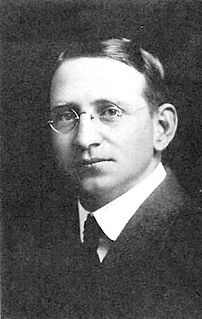Related Research Articles

The okapi, also known as the forest giraffe, Congolese giraffe, or zebra giraffe, is an artiodactyl mammal that is endemic to the northeast Democratic Republic of the Congo in central Africa. Although the okapi has striped markings reminiscent of zebras, it is most closely related to the giraffe. The okapi and the giraffe are the only living members of the family Giraffidae.

The San Diego Zoo Safari Park, originally named the San Diego Wild Animal Park until 2010, is an 1,800 acre zoo in the San Pasqual Valley area of San Diego, California, near Escondido. It is one of the largest tourist attractions in San Diego County. The park houses a large array of wild and endangered animals including species from the continents of Africa, Asia, Europe, North and South America, and Australia. This includes the largest collection of hoofed mammals in the world. The park is in a semi-arid environment, and one of its most notable features is the Africa Tram, which explores the expansive African exhibits. These free-range enclosures house such animals as antelopes, giraffes, buffalo, cranes, and rhinoceros. The park is also noted for its California condor breeding program.

The San Diego Zoo is a zoo in Balboa Park, San Diego, California, housing 4000 animals of more than 650 species and subspecies on 100 acres (40 ha) of Balboa Park leased from the City of San Diego. Its parent organization, San Diego Zoo Wildlife Alliance, is a private nonprofit conservation organization, and has one of the largest zoological membership associations in the world, with more than 250,000 member households and 130,000 child memberships, representing more than a half million people.

Sinclair Oil Corporation was an American petroleum corporation, founded by Harry F. Sinclair on May 1, 1916, as the Sinclair Oil and Refining Corporation by combining the assets of 11 small petroleum companies. Originally a New York corporation, Sinclair Oil reincorporated in Wyoming in 1976. The corporation's logo featured the silhouette of a large green sauropod dinosaur, based on the then-common idea that oil deposits beneath the earth came from the dead bodies of dinosaurs. It was ranked on the list of largest privately owned American corporations. It owned and operated refineries, gas stations, hotels, a ski resort, and a cattle ranch.

The Maryland Zoo — also known as The Maryland Zoo in Baltimore and formerly known as The Baltimore City Zoo or the Baltimore Zoo — is a 135-acre park located in historic Druid Hill Park in the northwestern area of the City of Baltimore, Maryland, (U.S.A.), with the postal address of 1876 Mansion House Drive. Druid Hill was opened in 1876 as the first major park purchase by the City under foreseeing Mayor Thomas Swann (1809-1883), and was later designed by famed nationally-known landscaper Frederick Law Olmsted (1822-1903), with additional work on various park buildings contributed by future Baltimore City Hall architect George A. Frederick (1842-1924), and Park Commissioner John H.B. Latrobe, who also was an accomplished lawyer, author, artist, amateur architect and civic leader. Olmsted had earlier won a contest for the design of plans for New York City's famed Central Park in mid-town Manhattan in 1858, a year after it opened, and worked on the massive public works project during its construction from 1858 to 1873. The Maryland Zoo is now currently home to over 2,000 animals, and is accredited by the Association of Zoos and Aquariums (AZA).
A zoological society is a group or organization, often a voluntary association, interested in fields of study related to the animal kingdom. These fields generally include zoology, animal physiology, pathology, veterinary medicine, wildlife conservation, conservation biology, and related topics. Zoological societies are often associated with the operation and/or management of zoos, public aquariums, veterinary hospitals, research institutions, and conservation projects, and with the publication of scientific journals and periodicals. The first such society was the Zoological Society of London, founded in 1826.

Laurence Monroe Klauber, was an American herpetologist and the foremost authority on rattlesnakes. He was the first curator of reptiles and amphibians at the San Diego Natural History Museum and Consulting Curator of Reptiles for the San Diego Zoo. He was also a businessman, inventor, and contributed to mathematics in his study of the distribution of prime numbers.

John Warne Gates, also known as "Bet-a-Million" Gates, was an American Gilded Age industrialist and gambler. He was a pioneer promoter of barbed wire. He was born and raised in what is now West Chicago, Illinois. He did not enjoy farm life and began offering neighbors various business propositions at an early age, including the sale of firewood to homes and to the local railroad. When he started a local grain brokerage that failed, Gates began spending time at the local railroad station and became reacquainted with the men he previously sold firewood to. He was invited to join their poker games and through this, Gates' aptitude for cards and other games of chance was developed.

Carl Henry Eigenmann was a German-American ichthyologist of the late nineteenth and early twentieth centuries, who, along with his wife Rosa Smith Eigenmann, and his zoology students is credited with identifying and describing for the first time 195 genera containing nearly 600 species of fishes of North America and South America. Especially notable among his published papers are his studies of the freshwater fishes of South America, the evolution and systematics of South American fishes, and for his analysis of degenerative evolution based on his studies of blind cave fishes found in parts of North America and in Cuba. His most notable works are The American Characidae (1917–1929) and A revision of the South American Nematognathi or cat-fishes (1890), in addition to numerous published papers such as "Cave Vertebrates of North America, a study of degenerative evolution" (1909) and "The fresh-water fishes of Patagonia and an examination of the Archiplata-Archelenis theory" (1909).

Frank Howard Buck was an American hunter, animal collector, and author, as well as a film actor, director, and producer. Beginning in the 1910s he made many expeditions into Asia for the purpose of hunting and collecting exotic animals, bringing over 100,000 live specimens back to the United States and elsewhere for zoos and circuses and earning a reputation as an adventurer. He co-authored seven books chronicling or based on his expeditions, beginning with 1930's Bring 'Em Back Alive, which became a bestseller. Between 1932 and 1943 he starred in seven adventure films based on his exploits, most of which featured staged "fights to the death" with various wild beasts. He was also briefly a director of the San Diego Zoo, displayed wild animals at the 1933–34 Century of Progress exhibition and 1939 New York World's Fair, toured with Ringling Bros. and Barnum & Bailey Circus, and co-authored an autobiography, 1941's All in a Lifetime. The Frank Buck Zoo in Buck's hometown of Gainesville, Texas, is named after him.
Joan Marie Embery is an American animal and environmental advocate. She was a Trustee of the Morris Animal Foundation, a professional Fellow of the Association of Zoos and Aquariums, a member of the Advisory Board of the UC Davis School of Veterinary Medicine's Wildlife Health Center, and a founding member the American Association of Zoo Keepers. The goodwill ambassador to the Zoological Society of San Diego for 32 years, she has also hosted educational series such as Animal Express, Animals of Africa, Baby Panda, and Challenges to Wildlife on public broadcasting. She has raised awareness of animals and wildlife conservation through her books, tours, projects, and appearances on television shows. Over the course of her decades-long career, she and her many animal ambassadors appeared nearly 70 times on The Tonight Show with Johnny Carson. According to Joan herself, however, that number is closer to 100 times, with additional appearances while Jay Leno was hosting. She was especially enjoyed by Johnny Carson and his audiences, where various animal guests included a baby elephant who could “paint”, a tarantula, a baby rhinoceros, a lion cub, and a pygmy marmoset who jumped from Joan’s arm to Johnny’s arm, up to his shoulder, then to the top of his head, before sitting quietly and urinating there, on live television. Joan said that the marmoset was “content” and “marking its territory,” given that apparently, it had its tail wrapped around Johnny Carson’s ear as well. She has also appeared on CBS This Morning, Hollywood Squares, Mr. Rogers, and Entertainment Tonight.

Joseph Cheesman Thompson (1874–1943) was a career medical officer in the United States Navy who attained the rank of commander before retirement in 1929. His foes called him 'Crazy Thompson', but to friends he was known as 'Snake', a nickname derived from his expertise in the field of herpetology.

San Diego Zoo Wildlife Alliance is a not-for-profit organization headquartered in San Diego that operates the San Diego Zoo and the San Diego Zoo Safari Park. Founded in 1916 as the Zoological Society of San Diego under the leadership of Harry M. Wegeforth, the organization claims the largest zoological society membership in the world, with more than 250,000 member households and 130,000 child memberships, representing more than half a million people. The organization's mission is to save species worldwide by uniting their expertise in animal care and conservation science with their dedication to inspiring passion for nature.

James Melven Dannaldson starred in the Frank Buck film Jacaré.

Belle Jennings Benchley, known as “The Zoo Lady,” was the director of the San Diego Zoo from 1927 to 1953, guiding its expansion from a small collection of animals to an innovative, world-class zoo.

Harry Milton Wegeforth was an American physician who founded the Zoological Society of San Diego and the San Diego Zoo. As a doctor he operated a thriving practice in San Diego, served briefly as president of the City Board of Health and as a surgeon for the San Diego and Arizona Railway, and established a hospital and clinic in the city's downtown district. He is best known, however, for founding the Zoological Society, which grew out of his involvement with the Panama–California Exposition in 1916, and for being the driving force behind the creation and early growth of the Zoo.

Louis John Gill was a San Diego-based architect and the nephew and one-time business partner of another famous San Diego architect, Irving Gill. The San Diego Historical Society calls Louis Gill "one of San Diego's greatest architects".
Frederick "Fred" Baker was an American physician and civic activist in San Diego, California. He was the prime mover in founding the Marine Biological Institution, which became the Scripps Institution of Oceanography. He was also a co-founder of the Zoological Society of San Diego and thus of the San Diego Zoo. He was a naturalist and an amateur malacologist.

Frank Stephens (1849–1937) was an American naturalist and the first director of the San Diego Natural History Museum. He was considered the pioneer naturalist of the Southwest, studying the mammals and birds of California, Arizona, and Baja California. His personal specimen collection of 2,000 birds and mammals, donated in 1910, was the foundation of the San Diego Natural History Museum's Birds & Mammals Department, now a major resource on bird and mammal species of western North America, including Baja California.
References
- 1 2 3 4 5 6 7 8 9 Wegeforth, Harry; Morgan, Neil (1990) [First published 1953]. It Began with a Roar!: The Beginning of the World-Famous San Diego Zoo (1990 ed.). San Diego: Zoological Society of San Diego. p. 18. ISBN 0-911461-14-0.
- ↑ Wegeforth and Morgan, p. 18–19.
- ↑ "Maryland Society". A National Register of the Society, Sons of the American Revolution. Louis H. Cornish. 2: 270. 1902. Retrieved 2015-07-20.
- ↑ Connor, Seymour V. (2010-06-15). "Wegefarth County". Handbook of Texas Online. Texas State Historical Association . Retrieved 2015-07-20.
- ↑ Wegeforth and Morgan, p. 32.
- ↑ "Wegeforth Elementary". sandi.net. San Diego Unified School District. Archived from the original on 2015-07-22. Retrieved 2015-07-20.
- ↑ Wegeforth and Morgan, p. 22.